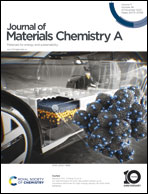Towards large area production: stretchability, flexibility, and stability of efficient printed organic tandem solar cells†
Abstract
Tandem organic solar cells are designed to expand the range of photon absorption responses and suppress transmission and thermalization losses. This technology enables one to harvest more of the power of the solar spectrum. The crucial criteria for designing a highly efficient arrangement of tandem cells are to (i) fabricate an interface junction layer with high transparency and (ii) ensure that the energy levels match well with the energy structure of the front and back cells. In this study, digital material deposition (DMD) as a new printing technology was applied to print a new stretchable and flexible conductive transparent electrode composed of PEDOT-PSS-SWCNTs-PEO-cellulose doped with HClO4, ZnO as an electron transport layer, and MoOx doped with HClO4 as a new efficient hole transport layer. In contrast, a binary layer composed of PEDOT-PSS doped with HClO4/ZnO was applied as an interface junction layer. P3HT-ICBA and PTB7-Th-PC[71]BM were used as the front and back heterojunction active layers for the tandem structures, respectively, and Ag was printed as top stretchable and flexible electrode via the metal–organic decomposition (MOD) process. The performance conversion efficiency (PCE) of more than 13% was achieved with strong stability, which is one of the best results obtained to date for solution-processed and flexible organic solar cells in view of combining both device stability and efficiency.



 Please wait while we load your content...
Please wait while we load your content...